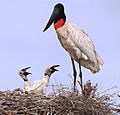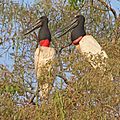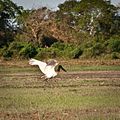Jabiru facts for kids
Quick facts for kids Jabiru |
|
|---|---|
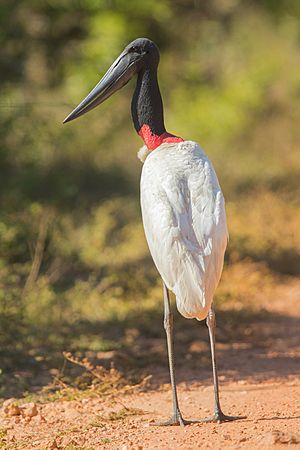 |
|
| Jabiru (Jabiru mycteria) | |
| Conservation status | |
| Scientific classification | |
| Kingdom: | |
| Phylum: | |
| Class: | |
| Order: | |
| Family: | |
| Genus: |
Jabiru
Hellmayr, 1906
|
| Species: |
J. mycteria
|
| Binomial name | |
| Jabiru mycteria (Lichtenstein, 1819)
|
|
The Jabiru (Jabiru mycteria) is a very large stork that lives in the Americas. You can find it from Mexico all the way down to Argentina, but not west of the Andes mountains. It's most common in the Pantanal area of Brazil and the Eastern Chaco part of Paraguay. The Jabiru is the only type of bird in its genus called Jabiru. Its name comes from an old language called Tupi-Guaraní, and it means "swollen neck."
Contents
What Does a Jabiru Look Like?
The Jabiru is the tallest flying bird in South America. It can stand as tall as 1.5 meters (about 5 feet)! Its wings can spread out to 2.8 meters (over 9 feet) wide. This big bird can weigh at least 8 kilograms (about 17.6 pounds).
Its beak is black and very long, up to 30 centimeters (about 1 foot). It's wide and points slightly upwards, ending in a sharp tip. Most of the Jabiru's feathers are white. However, its head and upper neck have no feathers and are black. At the bottom of its neck, there's a red pouch that can stretch.
Male and female Jabirus look similar, but the female is usually a bit smaller. Even though it might look a little clumsy on the ground, the Jabiru is a very strong and graceful flier.
Jabiru Habits and Diet
Jabirus often live in large groups close to rivers and ponds. They eat a lot of different things! Their diet mainly includes fish, mollusks, and amphibians like frogs. Sometimes, they will also eat reptiles and small mammals.
These birds are also helpful because they eat fresh carrion (dead animals) and dead fish. For example, if fish die when water dries up, Jabirus will eat them. This helps keep the water clean.
Building a Nest and Raising Chicks
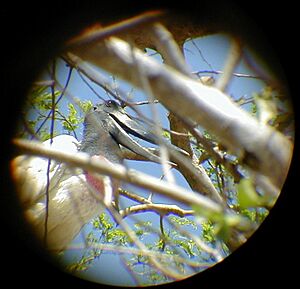
Both parent Jabirus work together to build their nest. They use twigs and place the nest high up in tall trees. They usually start building around August and September in the southern hemisphere. Each year, they add more to the nest, so it can grow to be several meters wide!
Sometimes, you might see a few Jabiru nests close together. They might even build their nests near other birds like herons. A female Jabiru lays 2 to 5 white eggs. Both parents take turns sitting on the eggs to keep them warm until they hatch. When a Jabiru is swimming, its long neck can sometimes look like the head of a snake, which can be confusing!
Protecting the Jabiru
Jabirus are found in many places, but there aren't huge numbers of them in any one area. The IUCN says they are a species of "least concern." This is good news, as they were once considered "near threatened" in 1988.
In Belize, Jabirus gained protected status in 1973. Since then, their numbers in that area have slowly gone up. They are also protected by the U.S. Migratory Bird Act, which helps keep them safe.
Images for kids
See also
 In Spanish: Jabirú para niños
In Spanish: Jabirú para niños




